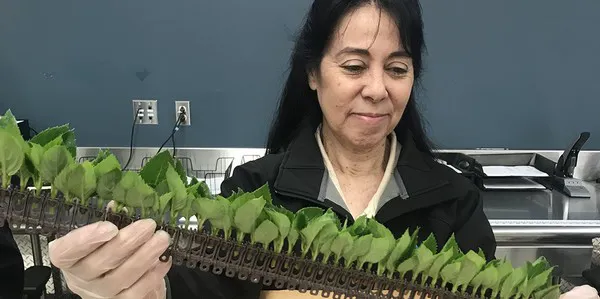When importing propagative materials, such as live plants and cuttings, every minute counts. Any delay at the port of entry could significantly impact their quality and cause significant economic loss to the nursery industry.
By Heather Curlett at www.aphis.usda.gov
For the last 3 years, the U.S. Department of Agriculture’s Plant Protection and Quarantine (PPQ) Program has worked with the U.S. nursery industry to design, test, and now implement a program that will effectively minimize pest risks in live plant cuttings and expedite their clearance at U.S. ports of entry. It’s called the Offshore Greenhouse Certification Program.
According to Karelyn Cruz, Offshore Certification Specialist with PPQ’s Preclearance and Offshore Programs, this program will help speed U.S. producers’ access to the diverse varieties of healthy plants they need to be competitive in the global marketplace while protecting our country against the entry of harmful plant pests.

Cuttings produced and exported under the Offshore Greenhouse Certification program may receive fewer or less frequent inspections at U.S. plant inspection stations. This will allow our inspectors to focus on higher risk shipments.
From inspections to certification
For decades, the United States, like most countries, has relied on inspections and treatments at ports of entry to keep harmful plant pests and diseases out of this country. But these are not necessarily the most efficient or effective tools for keeping pests out of the country. That’s because it’s simply not possible to inspect every shipment and find every pest or disease.
Over time, PPQ has been shifting away from port-of-entry inspections and treatments as a primary means of preventing pest entry to applying integrated measures—or systems approaches—in the country of origin before the product is exported to the United States. These systems approaches use two or more specific measures at critical points in the production process to reduce pest risks. The measures can include pest surveys, treatments, packaging or handling requirements, or certain sanitation steps, among others.
Making cuttings safer
At the heart of the Offshore Greenhouse Certification Program is a systems approach. It includes minimum requirements for greenhouse construction, security, production and sanitation, pest management, training, and recordkeeping. Facilities that are accepted into the program must agree to produce eligible generally admissible unrooted plant cuttings under the systems approach. In doing so, they will effectively mitigate most of the pest risk before the product ever leaves the exporting country.
“Our goal is to channel a significant portion of generally admissible plant cuttings into this certification program,” said Cruz. “In doing so, we will drive down pest and disease risks associated with unrooted cuttings, making them safer overall.”

The United States imports more than 1 billion plant cuttings annually, and nearly half of all plants sold in U.S. retail stores start from cuttings produced offshore.
Speeding up port of entry clearance
The Offshore Greenhouse Certification Program will also help to address peak season challenges at U.S. ports of entry. As cuttings arrive in the United States, they are transferred to one of PPQ’s 16 plant inspection stations. There experts examine the cuttings to ensure they meet U.S. import requirements and are free of pests and diseases. With the volume of plant cutting imports exceeding 1 billion per year, workload and staffing limitations can cause inspection delays.
But shipments produced and exported under the Offshore Greenhouse Certification Program will qualify for fewer or less frequent inspections at U.S. plant inspection stations, helping to expedite clearance and entry. This is especially important when the volume of arriving shipments peaks in late winter and early spring.

Facilities participating in the Offshore Greenhouse Certification Program will produce eligible generally admissible plant cuttings under a systems approach to reduce pest risks.
“The program creates a powerful incentive for offshore growers to produce a clean, pest-free product,” said Cruz. “It’s a triple win. U.S. industries are protected against damaging pests and diseases, importers can avoid costly delays at ports of entry, and PPQ inspectors can spend less time looking at low-risk shipments and more time focusing on those that present a greater threat.”
PPQ is currently accepting applications from interested offshore facilities and will begin scheduling onsite visits starting in November 2020.
“We are excited to bring this program online this year,” said Cruz. “It is a great example of how PPQ and industry can develop solutions that provide mutual benefit.”
To learn more about the program, visit PPQ’s Offshore Greenhouse Certification Program website.
Source: www.aphis.usda.gov
